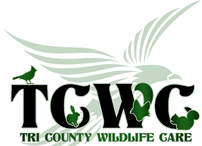Bats, Bats, BATS!
From Tri County Wildlife Care
There are a lot of myths about bats: they are blind, they will suck your blood, they are rodents (or birds). They are not blind, they will not suck your blood, and they are mammals. And, they are actually very helpful to humanity.
Most bats are small, only 3-5 inches in length, but with a wingspan of 12-16 inches. Some migrate between North and South America and some stay put. Their diet includes moth larvae, crickets, scorpions, beetles, grasshoppers and other insects. They will eat from the ground as well as pick off insects from leaves. They can even hear the insect footsteps on the ground and swoop down for dinner.
The Little Brown Bat may be the most abundant bat in North America. They roost in caves, hot attics and buildings, and hibernate in mines and caves. At dusk, they emerge and will eat more than their body weight each night. Many varieties have a lifespan of 34 years or more!
Bats consume enormous quantities of insects. To prove their effect on our corn crops, Southern Illinois University biologists studied bats by excluding them from some sections of corn and allowing them access to other sections. The larvae of the corn earworm causes more than $1 billion of damage each year by consuming the ears as well as contributing to a fungal infection in the kernels which can be toxic to humans and livestock. Where the bats were excluded, they found 60 percent more earworm larvae and more than 50 percent more kernel damage per ear. These little bats could save farmers of all crops between $3.7 billion to $53 billion a year.
Bats may also benefit humanity medically, since bat saliva contains an anticoagulant that could eventually help stroke and heart attack victims. Research into their echolocation, also known as bio sonar, may help blind people move about more safely. This is a perfect example of how “Saving Wildlife Saves Us!” These little animals help us thrive, and we need to help them thrive as well.
Like many other animals, bats are under threat from humans due to habitat loss. Entire species are at risk from a devastating fungal plague called “white-nose syndrome”, which has caused the death of over 6 million bats in just a few years. We must not lose this important part of our ecosystem. Help bats by not disturbing their roosting sites, don’t use pesticides, and protect the habitats (old-fashioned bridges and overpasses) where they roost.
Learn more about bats at Northern California Bats (http://norcalbats.org/aboutbats.shtml) including what to do if a bat is injured and needs help (http://norcalbats.org/rescue.shtml).
See also the “Links” section this month for other informative Bat Websites.
How to get a bat out of your house:
There are a lot of myths about bats: they are blind, they will suck your blood, they are rodents (or birds). They are not blind, they will not suck your blood, and they are mammals. And, they are actually very helpful to humanity.
Most bats are small, only 3-5 inches in length, but with a wingspan of 12-16 inches. Some migrate between North and South America and some stay put. Their diet includes moth larvae, crickets, scorpions, beetles, grasshoppers and other insects. They will eat from the ground as well as pick off insects from leaves. They can even hear the insect footsteps on the ground and swoop down for dinner.
The Little Brown Bat may be the most abundant bat in North America. They roost in caves, hot attics and buildings, and hibernate in mines and caves. At dusk, they emerge and will eat more than their body weight each night. Many varieties have a lifespan of 34 years or more!
Bats consume enormous quantities of insects. To prove their effect on our corn crops, Southern Illinois University biologists studied bats by excluding them from some sections of corn and allowing them access to other sections. The larvae of the corn earworm causes more than $1 billion of damage each year by consuming the ears as well as contributing to a fungal infection in the kernels which can be toxic to humans and livestock. Where the bats were excluded, they found 60 percent more earworm larvae and more than 50 percent more kernel damage per ear. These little bats could save farmers of all crops between $3.7 billion to $53 billion a year.
Bats may also benefit humanity medically, since bat saliva contains an anticoagulant that could eventually help stroke and heart attack victims. Research into their echolocation, also known as bio sonar, may help blind people move about more safely. This is a perfect example of how “Saving Wildlife Saves Us!” These little animals help us thrive, and we need to help them thrive as well.
Like many other animals, bats are under threat from humans due to habitat loss. Entire species are at risk from a devastating fungal plague called “white-nose syndrome”, which has caused the death of over 6 million bats in just a few years. We must not lose this important part of our ecosystem. Help bats by not disturbing their roosting sites, don’t use pesticides, and protect the habitats (old-fashioned bridges and overpasses) where they roost.
Learn more about bats at Northern California Bats (http://norcalbats.org/aboutbats.shtml) including what to do if a bat is injured and needs help (http://norcalbats.org/rescue.shtml).
See also the “Links” section this month for other informative Bat Websites.
How to get a bat out of your house:

